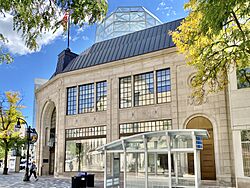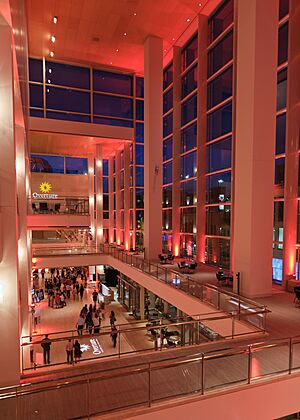Overture Center for the Arts facts for kids

The Overture Center in 2022
|
|
| Address | 201 State Street Madison, Wisconsin United States |
|---|---|
| Coordinates | 43°4′28″N 89°23′19″W / 43.07444°N 89.38861°W |
| Public transit | |
| Operator | Overture Center Foundation |
| Type | performing arts center |
| Capacity | Overture Hall: 2,255 Capitol Theater: 1,089 The Playhouse: 347 Promenade Hall: 252 Rotunda Stage: 350 |
| Construction | |
| Opened | 1928 (Capitol Theatre) |
| Reopened | 1980 (Madison Civic Center) 2004 (Overture Center for the Arts) |
| Architect | Cesar Pelli |
The Overture Center for the Arts is a special place for shows and art in Madison, Wisconsin, United States. It's a performing arts center and also has an art gallery. The center first opened its doors on September 19, 2004. It took the place of an older building called the Civic Center. Besides its many theaters, the Overture Center is also home to the Madison Museum of Contemporary Art.
Contents
History of the Overture Center
The idea for the Overture Center came from Jerome "Jerry" Frautschi and Pleasant Rowland. Pleasant Rowland is famous for starting the American Girl company. These two generous people gave a total of $205 million to pay for the entire building. This amazing building was designed by a famous architect named César Pelli. He also designed other well-known buildings, like the Petronas Towers in Malaysia.
The Overture Center for the Arts was built where the Madison Civic Center used to be. This was on the same block of State Street. Since it opened in 2004, the Overture Center has had several leaders. The first leader left in 2005. Later leaders included Michael Goldberg, Tom Carto, Ted DeDee, and Sandra Gajic.
Building the Center and Community Views
After their first gift of $100 million, Mr. Frautschi and Ms. Rowland gave another $100 million. They wanted to make sure the center was truly "state-of-the-art." This means it would have the best and newest features. Some people in the city had different ideas about the project. Some worried it might change the feel of nearby State Street. Others thought the new cultural center might only be for wealthy people. They also worried it would make it harder for local artists to perform there.
After the center was built, there were some worries about how it would keep getting money. People were concerned that the Overture's savings might get low. During a time of economic difficulty, there was a chance the city might need to help with funding. These worries grew when a special fund set up to help pay for the building and its operations was used up. This meant some building costs still needed to be paid. Mr. Frautschi, Ms. Rowland, and others helped pay these remaining costs. The center also had to reduce its staff. By 2013, the Overture Center had successfully overcome its financial challenges.
Discussions About Miss Saigon
In 2014, the Overture Center started a program called the Racial Equity Initiative. This was after a report showed big differences in how different racial groups were treated in Dane County. As part of this program, Ed Holmes became the center's first director of diversity and inclusion in 2016. His goal was to use art to help make things fairer in the community.
In April 2019, the Overture Center planned to show a musical called Miss Saigon. This caused some discussion within the Asian American community. Some people, like scholar Timothy Yu, felt the musical showed Asian women in ways that were not fair or accurate. They believed it used harmful stereotypes. Because of these concerns, the Overture Center planned a discussion event. It was called "Asian American Perspectives on Miss Saigon." This event was meant to talk about how Asian Americans are shown in media.
However, the event faced several changes. A main speaker was replaced, and some critical materials were removed. This led to more tension. Sandra Gajic, the president of the Overture Center, said the discussion felt "adversarial." She felt it unfairly blamed the Overture Center and her for showing Miss Saigon. She also said that many Vietnamese and Asian people enjoy the show.
On the day the event was supposed to happen, the Overture Center delayed it. They said they were worried about the tone of the discussion. In response, the Asian American speakers held their own discussion outside the venue. The cancellation and how the event was handled led to apologies from Ms. Gajic. She admitted mistakes were made and promised to think differently about future shows and discussions.
The discussion continued when Edgewood College canceled a planned trip to see Miss Saigon. They explained that they felt the show's portrayal of the Vietnam War and its characters reinforced negative stereotypes.
Performance Spaces
The Overture Center has several different spaces for performances.
Overture Hall
Overture Hall is the biggest theater in the center. It has 2,251 seats spread across four levels. The hall has a beautiful design and was built to have excellent sound. It is home to the Pleasant Rowland Concert Organ, a very large organ custom-built in Germany. This theater is where the Madison Symphony Orchestra, Madison Opera, and Madison Ballet perform.
Capitol Theater
During the Overture's construction, the Oscar Mayer Theater was restored. This theater was originally built in 1928 as the Capitol Theater and was a movie palace. It was made smaller and renamed the Capitol Theater. It reopened in November 2005 with a performance by the Wisconsin Chamber Orchestra. This theater can seat up to 1,089 people. It has an organ built by the Barton Organ Company from Oshkosh. The Wisconsin Chamber Orchestra and CTM Madison Family Theatre perform here regularly. Many traveling shows and concerts also visit.
The Playhouse
The Playhouse is a smaller, more cozy performance space. It replaced the old Isthmus Playhouse. It was updated for the Madison Repertory Theatre, which used to be its main company. After that group closed, Forward Theater Company became its new resident company.
Other Venues and Galleries
The Overture Center also has other smaller spaces. These include Promenade Hall, Rotunda Stage, Wisconsin Studio, and Rotunda Studio. The center also has four art galleries. The Overture Galleries show art by local and state artists. The James Watrous Gallery is also inside the center. It is run by the Wisconsin Academy of Sciences, Arts, and Letters.
Famous Performers
Many famous artists have performed at the Capitol Theater and Overture Center. Here is a list of some of them:
- Dream Theater
- Bryan Adams
- Alabama Shakes
- Tori Amos
- Laurie Anderson
- Criss Angel
- Joan Baez
- The Beach Boys
- Belle and Sebastian
- Tony Bennett
- Mike Birbiglia
- Andrew Bird
- Blue Man Group
- Blues Traveler
- Anthony Bourdain
- Jim Brickman
- Jackson Browne
- Mary Chapin Carpenter
- Johnny Cash
- June Carter Cash and the Carter Family
- Cheap Trick
- Chicago
- The Clancy Brothers
- John Cleese
- Jimmy Cliff
- Billy Cobham
- Perry Como
- Harry Connick Jr.
- Larry Coryell
- Alice Cooper
- Bill Cosby
- Elvis Costello
- Bo Diddley
- Ani DiFranco
- Bob Dylan
- Earth, Wind & Fire
- Susan Egan
- Michael Feinstein
- Fitz and the Tantrums
- Jane Fonda
- Peter Gabriel
- The Goo Goo Dolls
- Kathy Griffin
- Buddy Guy
- Sammy Hagar
- Merle Haggard
- Hall & Oates
- Corey Hart
- Mayer Hawthorne
- Indigo Girls
- Robert Irvine
- Chris Isaak
- Joe Jackson
- Al Jarreau
- Jars of Clay
- Jethro Tull
- Meg Johnson
- Norah Jones
- Garrison Keillor
- B.B. King
- Gladys Knight
- Diana Krall
- Patti LaBelle
- Ladysmith Black Mambazo
- k.d. lang
- Jonny Lang
- Legion of Mary
- John Leguizamo
- Ramsey Lewis
- Gordon Lightfoot
- Little Big Town
- Lisa Loeb
- Kenny Loggins
- Lyle Lovett
- Patti LuPone
- Yo-Yo Ma
- Taj Mahal
- Bill Maher
- Mannheim Steamroller
- Branford Marsalis
- Wynton Marsalis
- Steve Martin
- Matisyahu
- Kathy Mattea
- John Mayall & the Bluesbreakers
- Idina Menzel
- Natalie Merchant
- Ingrid Michaelson
- Liza Minnelli
- Colin Mochrie and Brad Sherwood
- Mormon Tabernacle Choir
- Graham Nash
- Willie Nelson
- Bob Newhart
- Ted Nugent
- Gary Numan
- Laura Nyro
- Karen Olivo
- Bonnie Owens
- Ken Page
- Christopher Parkening
- Dolly Parton
- Carl Perkins
- Itzhak Perlman
- Bernadette Peters
- The Police
- Portugal. The Man
- John Prine
- Bonnie Raitt
- Lou Reed
- Return to Forever
- The Righteous Brothers
- Molly Ringwald
- Joan Rivers
- Diana Ross
- David Sanborn
- The Searchers
- David Sedaris
- Jerry Seinfeld
- Shinedown
- Martin Short
- Yakov Smirnoff
- Mavis Staples
- The Statler Brothers
- Straight No Chaser
- String Driven Thing
- Styx
- John Tartaglia
- The Temptations
- Thompson Twins
- George Thorogood & the Destroyers
- Toad the Wet Sprocket
- Lily Tomlin
- Peter Tosh
- Tower of Power
- Brandon Uranowitz
- Michal Urbaniak
- Anna Vogelzang
- Muddy Waters
- Doc Watson
- Weather Report
- Lawrence Welk
- Ron White
- Roger Whittaker
- Wilco
- Hank Williams Jr.
- George Winston
- XTC
- Weird Al Yankovic
- Yanni
- Peter Yarrow and Noel Paul Stookey
- Steve Young
- ZZ Top
- Frank Zappa
- Warren Zevon
See also
- List of concert halls


